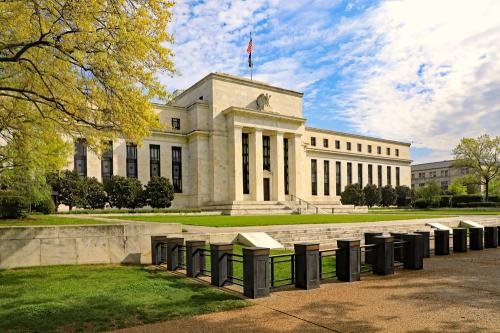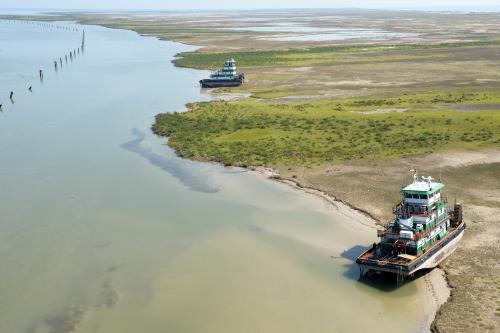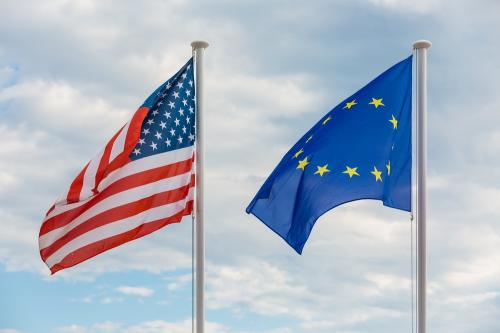Central banks have a choice when it comes to confronting climate change, BlackRock’s Isabelle Mateos y Lago said at a recent Hutchins Center on Fiscal & Monetary Policy event. They can navigate climate change and the transition to net zero carbon emissions, or they can go further and drive the transition to net zero. But ignoring climate change is not an option.
Mateos y Lago, global head of BlackRock’s Official Institutions Group and a former senior International Monetary Fund official, spoke at a Hutchins Center forum in early March 2022 on challenges facing Jerome Powell in his second four-year term as Fed chair. Climate change is a particularly contentious issue. Senate Republicans are blocking the nomination of Sarah Bloom Raskin to the Fed to be vice chair for (bank) supervision in part because of she has said in the past that the Fed should take an aggressive role in fighting climate change. This is a lightly edited summary of her remarks. (The video is also available.)
Climate change clearly poses a significant economic threat, Mateos y Lago said. “There are all sorts of estimates about the impact of climate change, but one we like to cite is the damage from climate change in a business-as-usual scenario would equate 25 percent of global GDP by 2040,” she said. “So we’re not talking the second half of this century when we’re all dead. We’re talking next 20 years. For the U.S. that figure is 8 percent. It’s very material.”
So what does this mean for the Federal Reserve? Powell has said that the Fed’s role is limited, but important. “And I think it’s a brilliant line,” Mateos y Lago said. “Most central bankers would agree with it. No central bank in the world is calling for expanding its mandate to include saving the planet. No central bank is calling for filling a void left by other policymakers. Having said that, they do have different conceptions of what does fall under this umbrella of a limited but important role.”
Central banks, she said, strive for the maximum overlap between their legal mandate (in the U.S., maximum employment and price stability) and what she called “their social license to operate,” both of which differ by country and change over time. For decades, neither the mandate nor the social license led central banks to consider climate change.
But that has changed—and it isn’t the only thing that has changed. The Fed in 2020, for instance, redefined “maximum employment” to be a “broad and inclusive goal.” Why? “Because it felt it made sense within the mandate and because it felt its social license to operate required it,” Mateos y Lago said.
Given how politically divisive discussion of climate change is in the U.S., Mateos y Lago suggested that the Fed wants to err on the side of sticking with what the legal mandate requires—that is, navigating climate change rather than driving the policy response. Powell’s public statements reflect this approach, focusing on making sure that the banks that the Fed supervises understand and manage the risks posed by climate change, including stress testing with various scenarios.
“And that’s really important because this stuff is complicated, most institutions don’t have the data understanding how the scenarios can be built so that they make sense, all that takes time. And so there’s a lot of learning by doing that needs to happen so it makes sense for the Fed to do this,” Mateos y Lago said. “This does not include green lending incentives or brown lending penalties. Some central banks feel their population, their public opinion, wants them to do that, and they’ve been doing it.” That is not the case in the U.S.
Given the potential macroeconomic impact of climate change—or of policies aimed at reducing the harm of climate change—“it would be completely odd for central banks not to incorporate it as best they can in their macro modeling,” she said. “We’re facing a massive reallocation of resources across the entire economy over the next 10 years. But you want to do that with a 2 percent inflation target or a 4 percent inflation target? You know, probably having a slightly higher one might help.”
The scope of the Fed’s approach to climate will evolve over time. The key, she said, is “not to overreach and not to become hostage to political debates…. But equally there are basic elements that are fully in the scope of the Fed’s core mandate of financial stability and monetary stability. Not talking about climate change just because it’s polarizing wouldn’t be a good idea either.”
The Brookings Institution is financed through the support of a diverse array of foundations, corporations, governments, individuals, as well as an endowment. A list of donors can be found in our annual reports published online here. The findings, interpretations, and conclusions in this report are solely those of its author(s) and are not influenced by any donation.





Commentary
Climate change & the Fed: Navigating the transition to net zero
March 7, 2022